The Impact of Technological Games on Children's Development
VerifiedAdded on 2023/04/11
|22
|1318
|500
Report
AI Summary
This report delves into the effects of technological games on children, examining the potential negative impacts on their behavior and development. It discusses the link between violent video games and aggression, the imitation of characters, and the potential for social isolation. The report draws on research from various publications, including studies by Gentile et al. (2004), Lin and Lepper (1987), and Anderson and Dill (2000), to support its arguments. It also references theories from Vygotsky, Freud, and Montessori to provide a broader context for understanding child development and learning. The report concludes by emphasizing the importance of parental monitoring and balanced technology use to mitigate potential harms, offering a comprehensive overview of the topic.
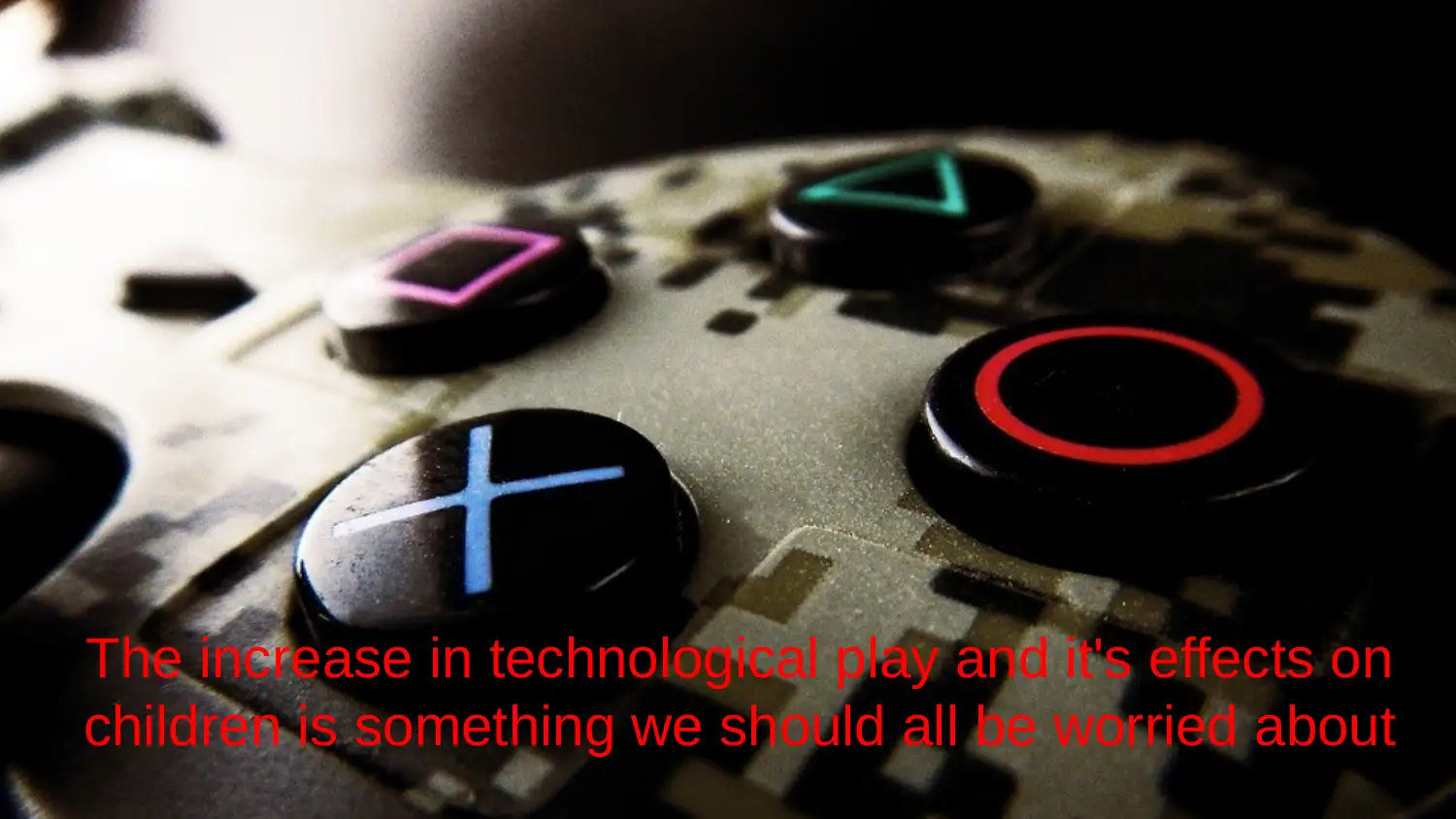
The increase in technological play and it's effects on
children is something we should all be worried about
children is something we should all be worried about
Paraphrase This Document
Need a fresh take? Get an instant paraphrase of this document with our AI Paraphraser
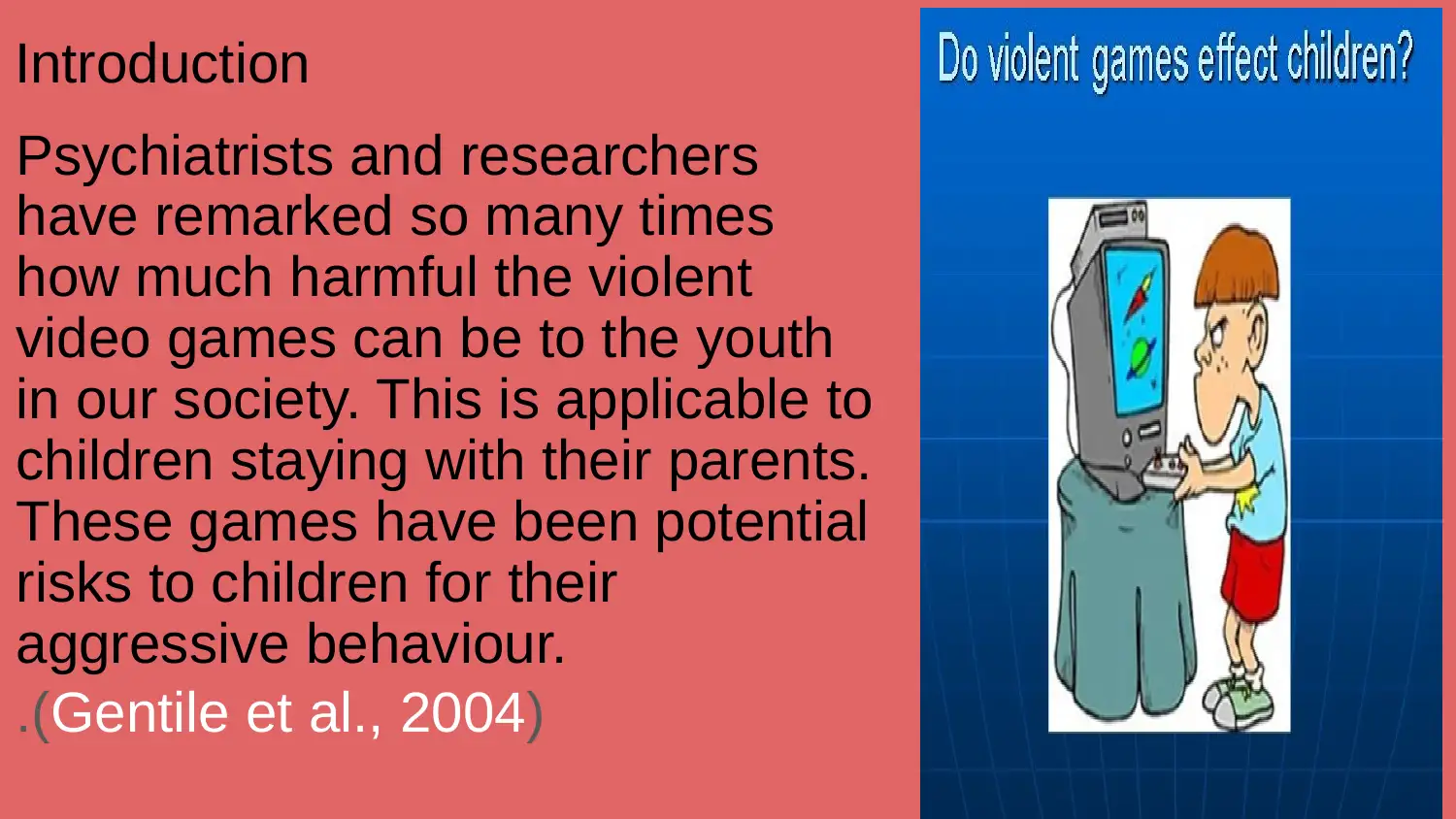
Introduction
Psychiatrists and researchers
have remarked so many times
how much harmful the violent
video games can be to the youth
in our society. This is applicable to
children staying with their parents.
These games have been potential
risks to children for their
aggressive behaviour.
.(Gentile et al., 2004) 2
Psychiatrists and researchers
have remarked so many times
how much harmful the violent
video games can be to the youth
in our society. This is applicable to
children staying with their parents.
These games have been potential
risks to children for their
aggressive behaviour.
.(Gentile et al., 2004) 2
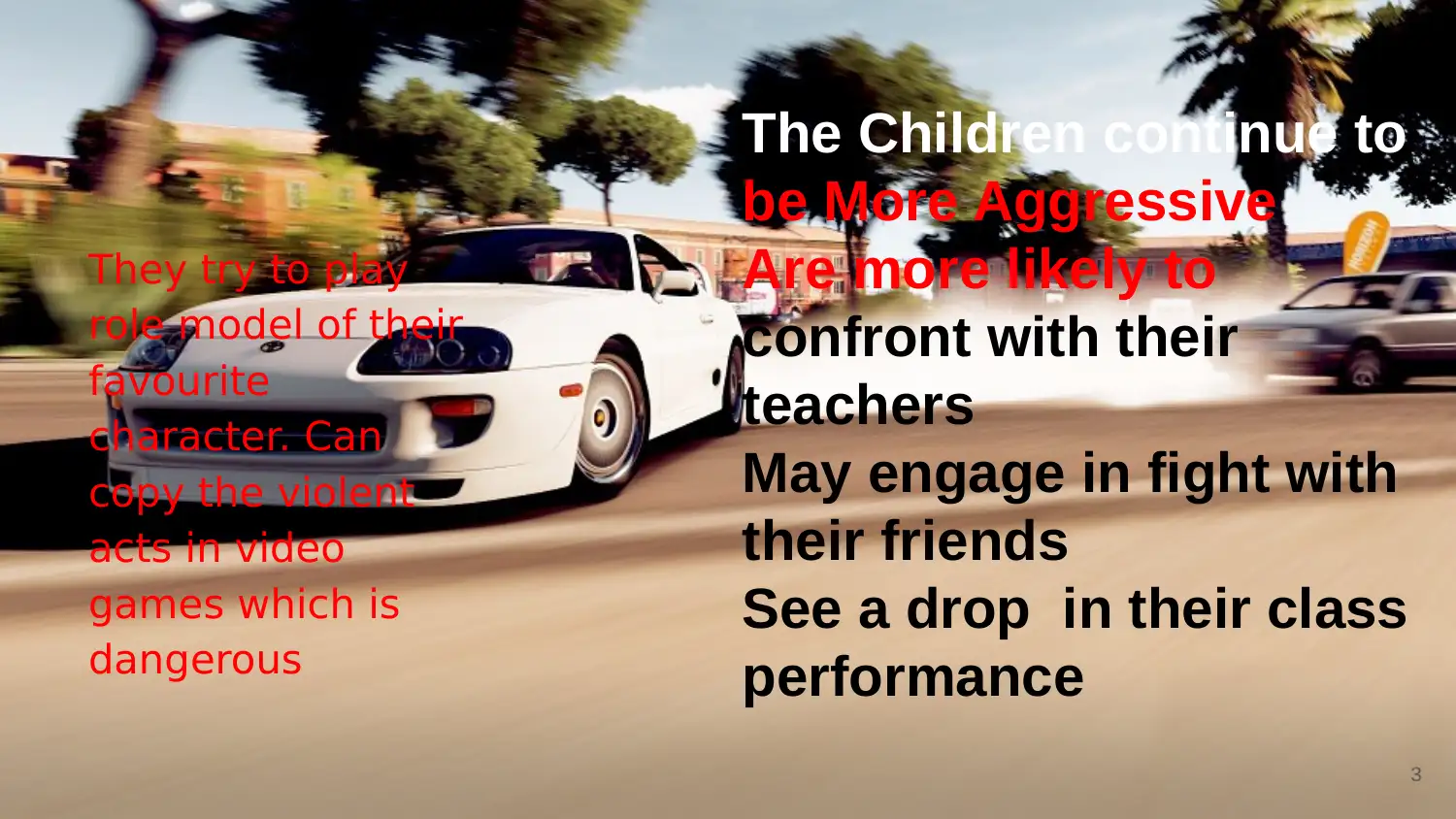
3
They try to play
role model of their
favourite
character. Can
copy the violent
acts in video
games which is
dangerous
The Children continue to
be More Aggressive
Are more likely to
confront with their
teachers
May engage in fight with
their friends
See a drop in their class
performance
They try to play
role model of their
favourite
character. Can
copy the violent
acts in video
games which is
dangerous
The Children continue to
be More Aggressive
Are more likely to
confront with their
teachers
May engage in fight with
their friends
See a drop in their class
performance
⊘ This is a preview!⊘
Do you want full access?
Subscribe today to unlock all pages.

Trusted by 1+ million students worldwide
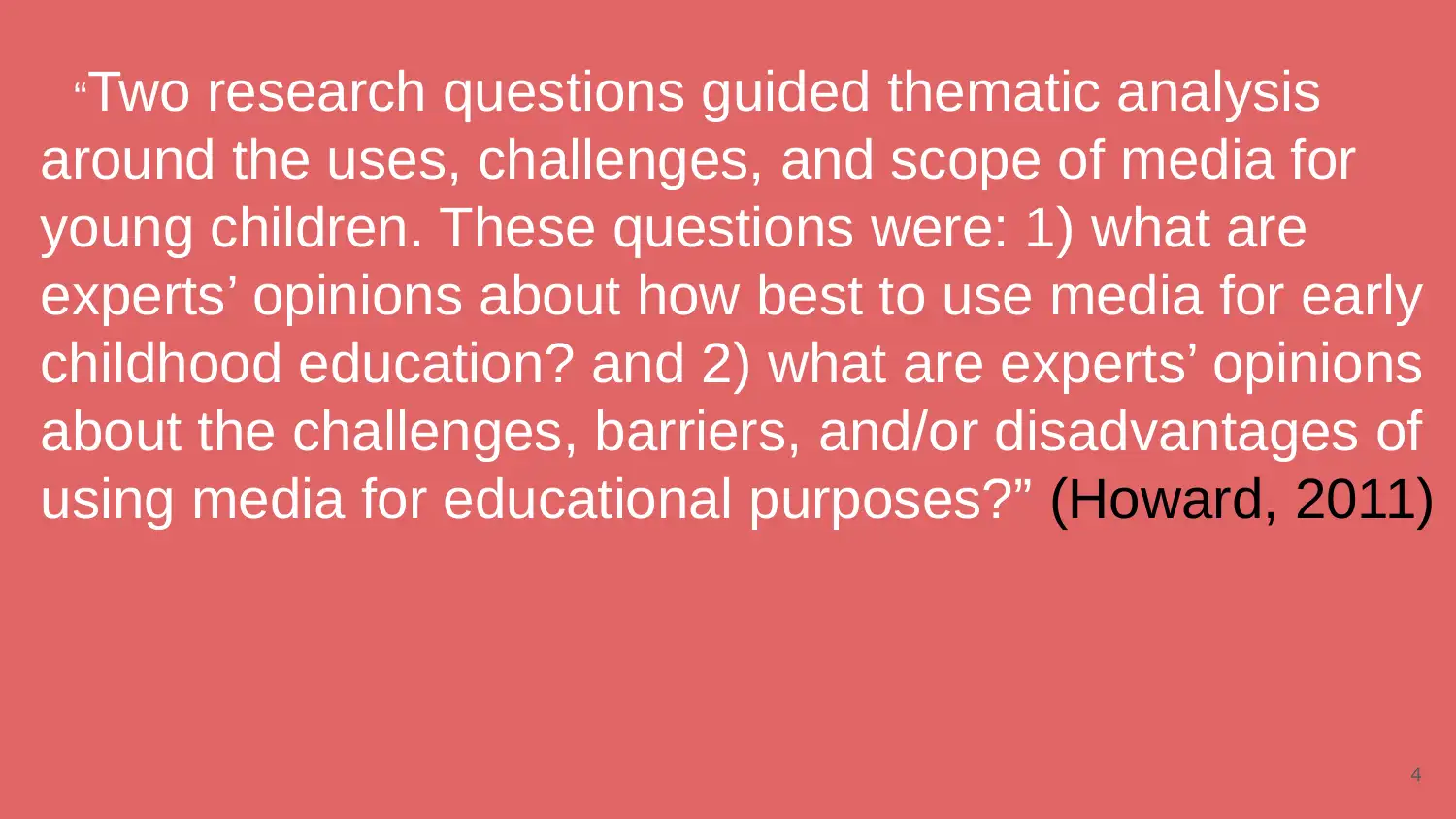
4
“Two research questions guided thematic analysis
around the uses, challenges, and scope of media for
young children. These questions were: 1) what are
experts’ opinions about how best to use media for early
childhood education? and 2) what are experts’ opinions
about the challenges, barriers, and/or disadvantages of
using media for educational purposes?” (Howard, 2011)
“Two research questions guided thematic analysis
around the uses, challenges, and scope of media for
young children. These questions were: 1) what are
experts’ opinions about how best to use media for early
childhood education? and 2) what are experts’ opinions
about the challenges, barriers, and/or disadvantages of
using media for educational purposes?” (Howard, 2011)
Paraphrase This Document
Need a fresh take? Get an instant paraphrase of this document with our AI Paraphraser
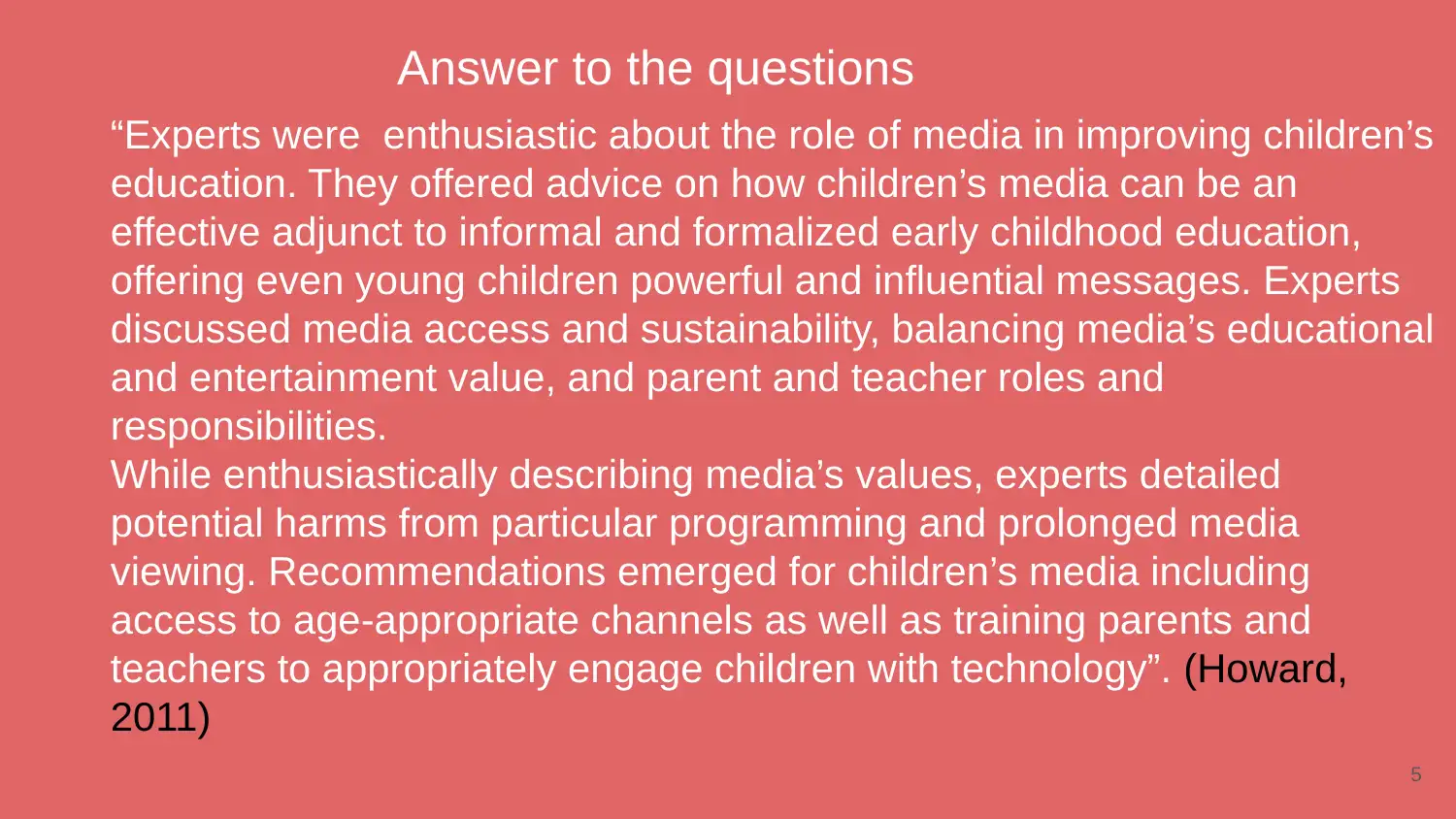
5
“Experts were enthusiastic about the role of media in improving children’s
education. They offered advice on how children’s media can be an
effective adjunct to informal and formalized early childhood education,
offering even young children powerful and influential messages. Experts
discussed media access and sustainability, balancing media’s educational
and entertainment value, and parent and teacher roles and
responsibilities.
While enthusiastically describing media’s values, experts detailed
potential harms from particular programming and prolonged media
viewing. Recommendations emerged for children’s media including
access to age-appropriate channels as well as training parents and
teachers to appropriately engage children with technology”. (Howard,
2011)
Answer to the questions
“Experts were enthusiastic about the role of media in improving children’s
education. They offered advice on how children’s media can be an
effective adjunct to informal and formalized early childhood education,
offering even young children powerful and influential messages. Experts
discussed media access and sustainability, balancing media’s educational
and entertainment value, and parent and teacher roles and
responsibilities.
While enthusiastically describing media’s values, experts detailed
potential harms from particular programming and prolonged media
viewing. Recommendations emerged for children’s media including
access to age-appropriate channels as well as training parents and
teachers to appropriately engage children with technology”. (Howard,
2011)
Answer to the questions
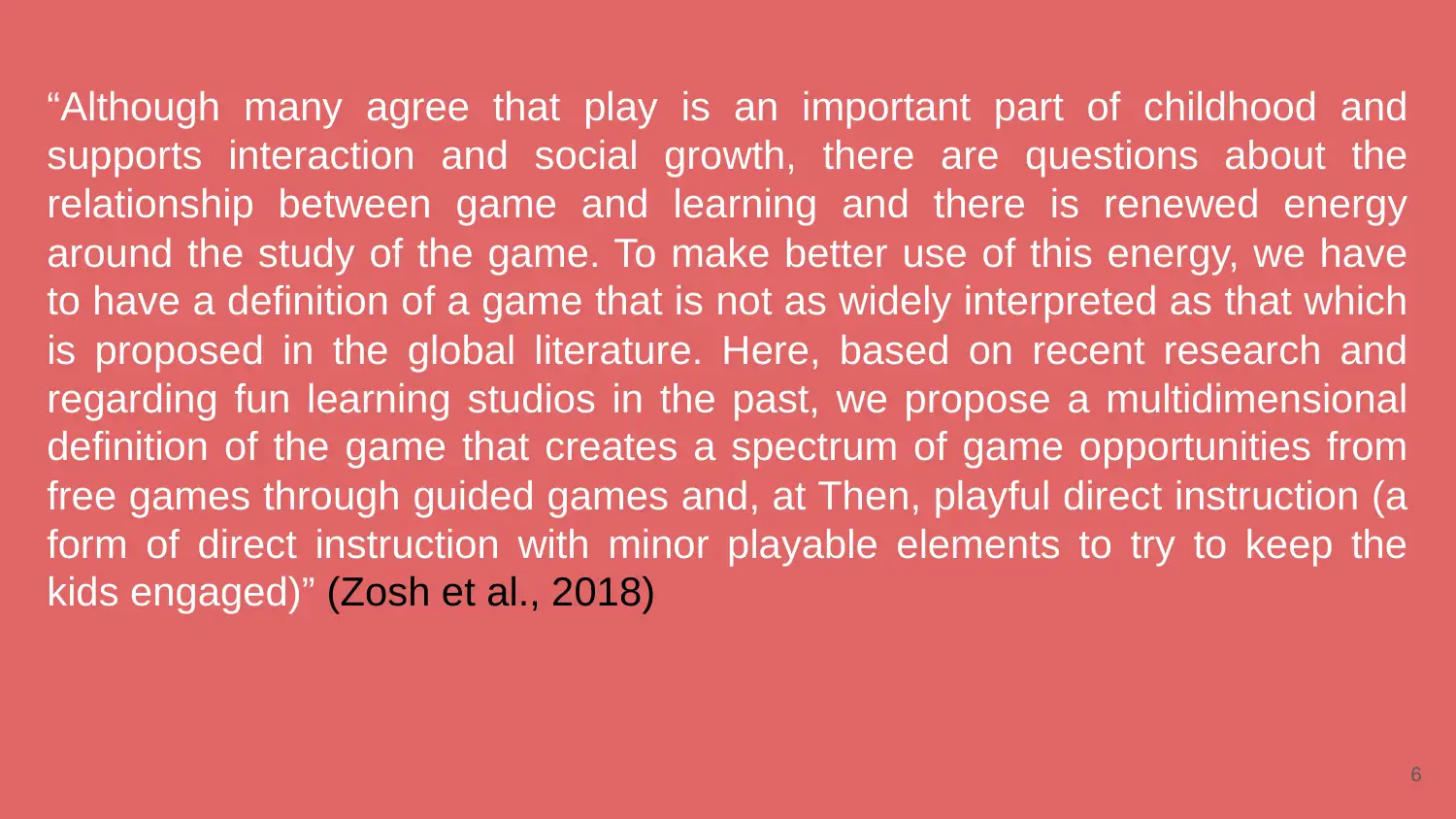
6
“Although many agree that play is an important part of childhood and
supports interaction and social growth, there are questions about the
relationship between game and learning and there is renewed energy
around the study of the game. To make better use of this energy, we have
to have a definition of a game that is not as widely interpreted as that which
is proposed in the global literature. Here, based on recent research and
regarding fun learning studios in the past, we propose a multidimensional
definition of the game that creates a spectrum of game opportunities from
free games through guided games and, at Then, playful direct instruction (a
form of direct instruction with minor playable elements to try to keep the
kids engaged)” (Zosh et al., 2018)
“Although many agree that play is an important part of childhood and
supports interaction and social growth, there are questions about the
relationship between game and learning and there is renewed energy
around the study of the game. To make better use of this energy, we have
to have a definition of a game that is not as widely interpreted as that which
is proposed in the global literature. Here, based on recent research and
regarding fun learning studios in the past, we propose a multidimensional
definition of the game that creates a spectrum of game opportunities from
free games through guided games and, at Then, playful direct instruction (a
form of direct instruction with minor playable elements to try to keep the
kids engaged)” (Zosh et al., 2018)
⊘ This is a preview!⊘
Do you want full access?
Subscribe today to unlock all pages.

Trusted by 1+ million students worldwide
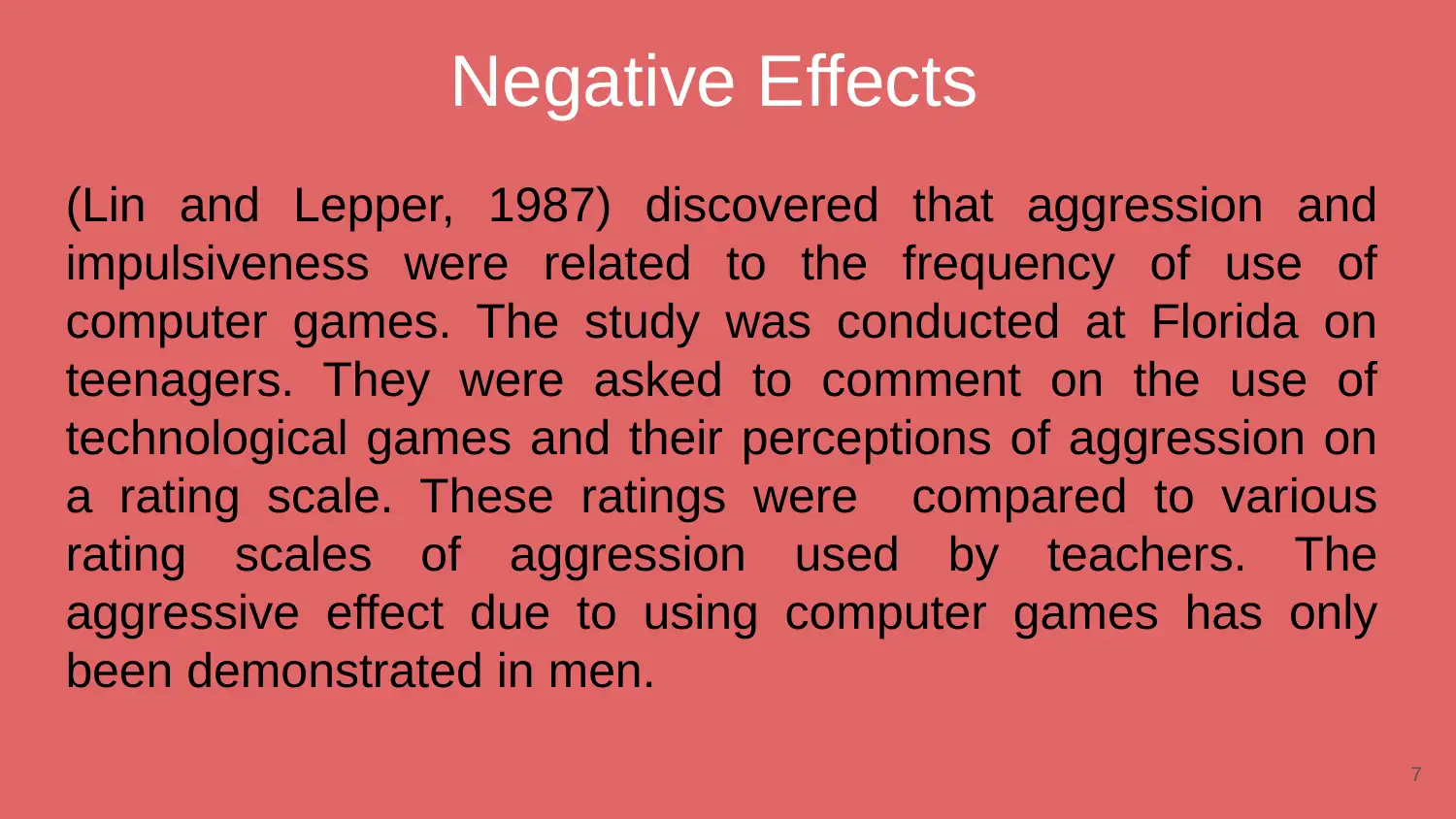
7
Negative Effects
(Lin and Lepper, 1987) discovered that aggression and
impulsiveness were related to the frequency of use of
computer games. The study was conducted at Florida on
teenagers. They were asked to comment on the use of
technological games and their perceptions of aggression on
a rating scale. These ratings were compared to various
rating scales of aggression used by teachers. The
aggressive effect due to using computer games has only
been demonstrated in men.
Negative Effects
(Lin and Lepper, 1987) discovered that aggression and
impulsiveness were related to the frequency of use of
computer games. The study was conducted at Florida on
teenagers. They were asked to comment on the use of
technological games and their perceptions of aggression on
a rating scale. These ratings were compared to various
rating scales of aggression used by teachers. The
aggressive effect due to using computer games has only
been demonstrated in men.
Paraphrase This Document
Need a fresh take? Get an instant paraphrase of this document with our AI Paraphraser
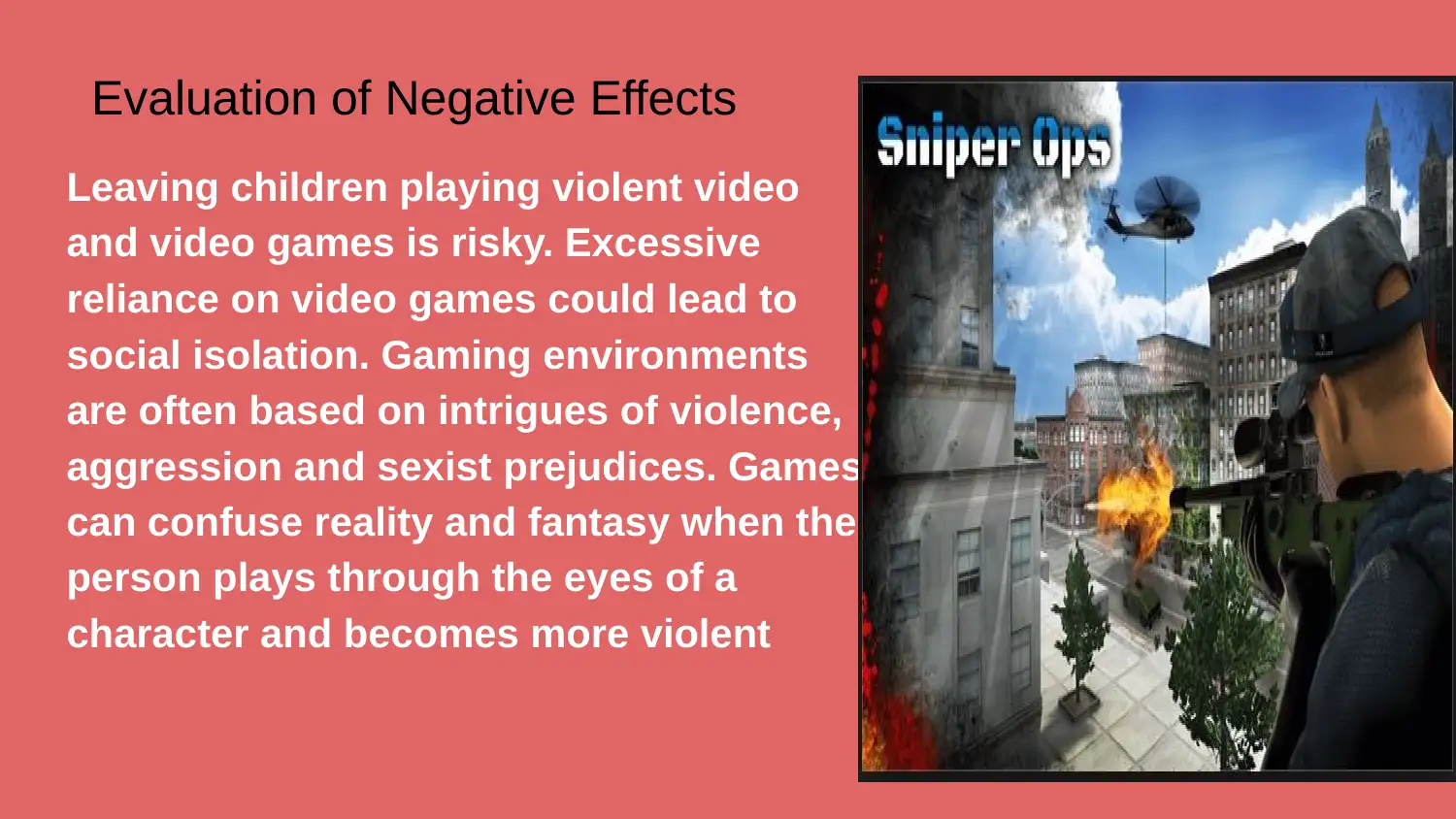
Evaluation of Negative Effects
Leaving children playing violent video
and video games is risky. Excessive
reliance on video games could lead to
social isolation. Gaming environments
are often based on intrigues of violence,
aggression and sexist prejudices. Games
can confuse reality and fantasy when the
person plays through the eyes of a
character and becomes more violent
8
Leaving children playing violent video
and video games is risky. Excessive
reliance on video games could lead to
social isolation. Gaming environments
are often based on intrigues of violence,
aggression and sexist prejudices. Games
can confuse reality and fantasy when the
person plays through the eyes of a
character and becomes more violent
8
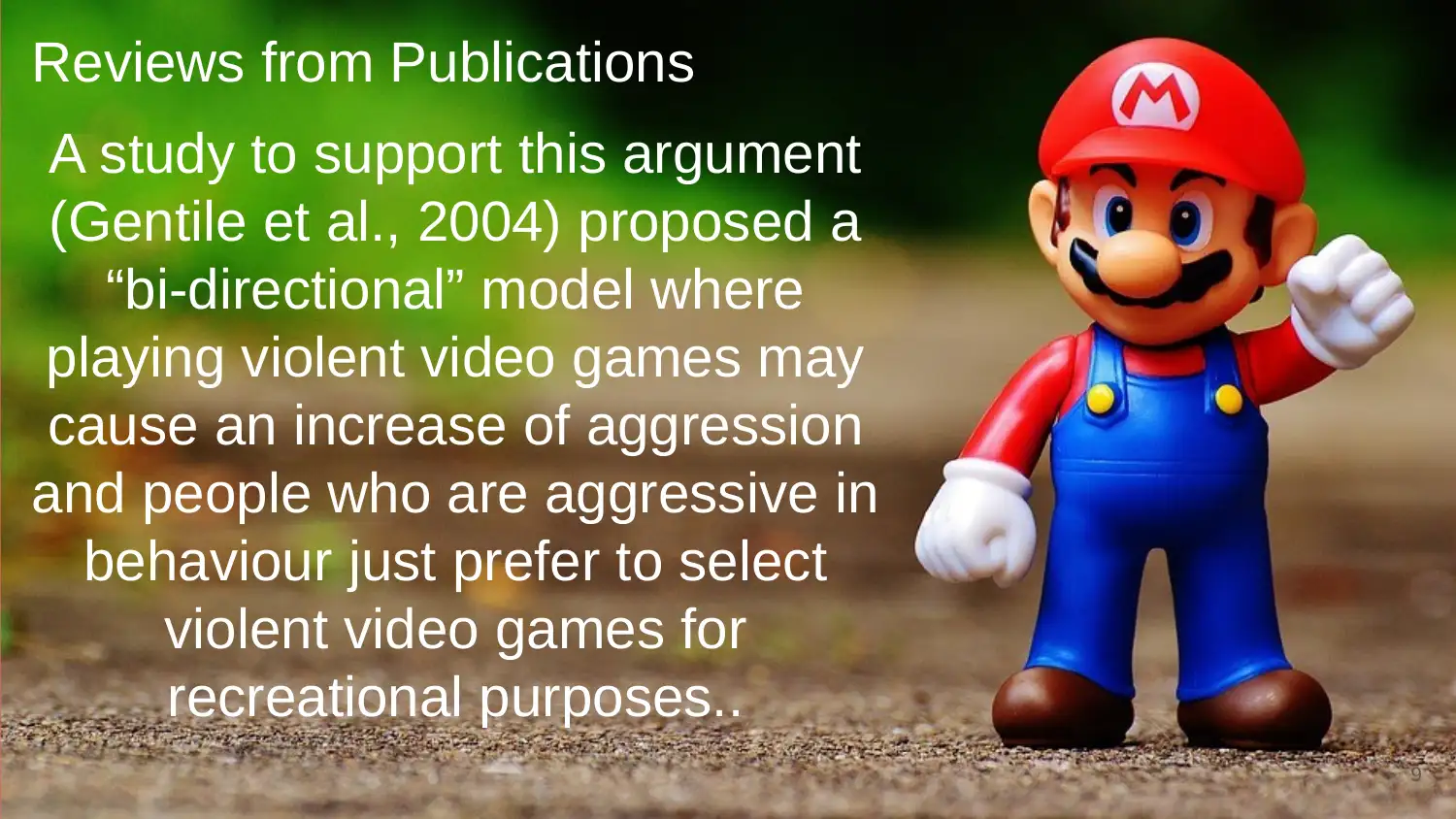
Reviews from Publications
A study to support this argument
(Gentile et al., 2004) proposed a
“bi-directional” model where
playing violent video games may
cause an increase of aggression
and people who are aggressive in
behaviour just prefer to select
violent video games for
recreational purposes..
9
A study to support this argument
(Gentile et al., 2004) proposed a
“bi-directional” model where
playing violent video games may
cause an increase of aggression
and people who are aggressive in
behaviour just prefer to select
violent video games for
recreational purposes..
9
⊘ This is a preview!⊘
Do you want full access?
Subscribe today to unlock all pages.

Trusted by 1+ million students worldwide
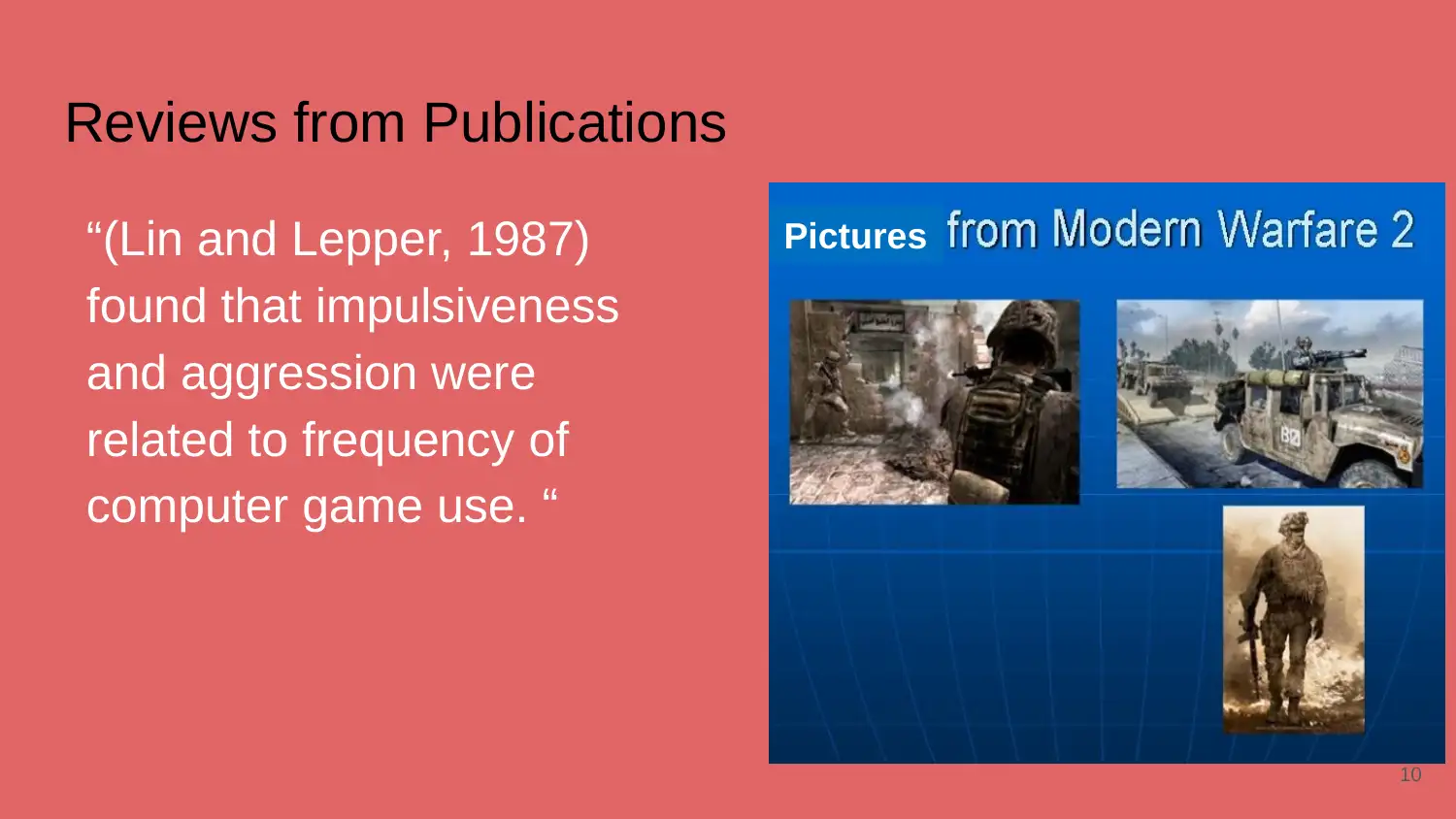
Reviews from Publications
“(Lin and Lepper, 1987)
found that impulsiveness
and aggression were
related to frequency of
computer game use. “
10
Pictures
“(Lin and Lepper, 1987)
found that impulsiveness
and aggression were
related to frequency of
computer game use. “
10
Pictures
Paraphrase This Document
Need a fresh take? Get an instant paraphrase of this document with our AI Paraphraser
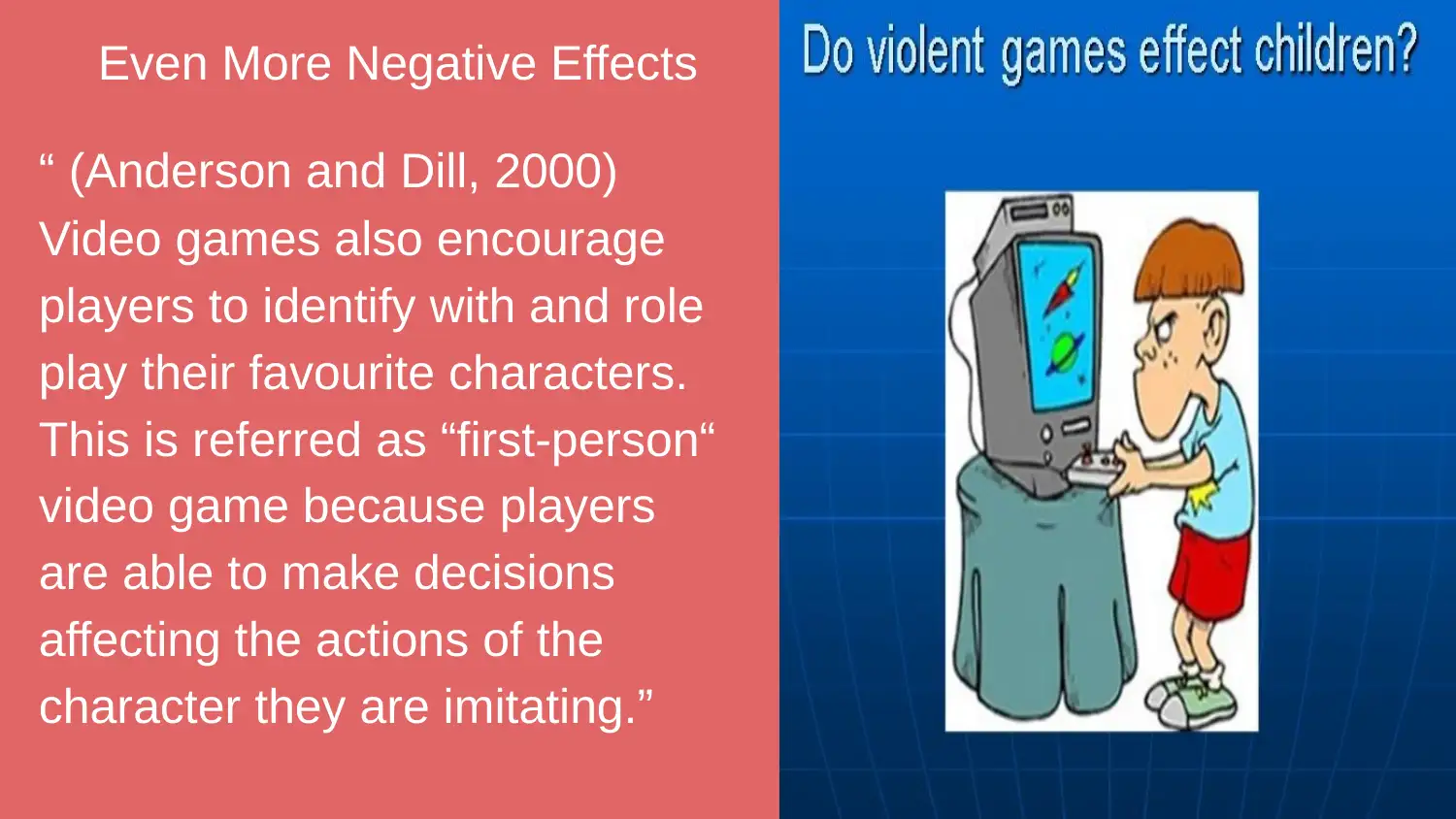
“ (Anderson and Dill, 2000)
Video games also encourage
players to identify with and role
play their favourite characters.
This is referred as “first-person“
video game because players
are able to make decisions
affecting the actions of the
character they are imitating.”
11
Even More Negative Effects
Video games also encourage
players to identify with and role
play their favourite characters.
This is referred as “first-person“
video game because players
are able to make decisions
affecting the actions of the
character they are imitating.”
11
Even More Negative Effects
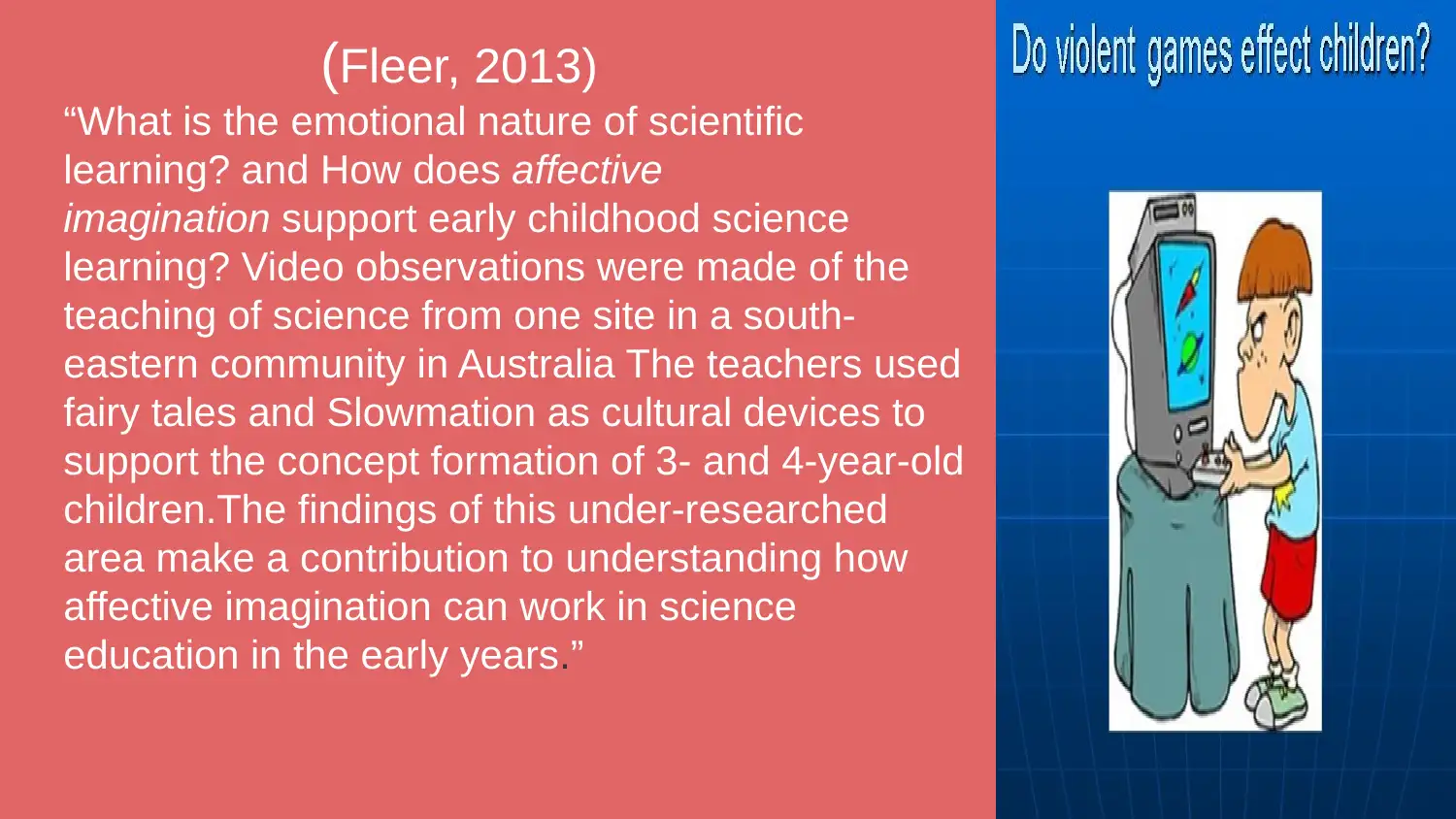
12
(Fleer, 2013)
“What is the emotional nature of scientific
learning? and How does affective
imagination support early childhood science
learning? Video observations were made of the
teaching of science from one site in a south-
eastern community in Australia The teachers used
fairy tales and Slowmation as cultural devices to
support the concept formation of 3- and 4-year-old
children.The findings of this under-researched
area make a contribution to understanding how
affective imagination can work in science
education in the early years.”
(Fleer, 2013)
“What is the emotional nature of scientific
learning? and How does affective
imagination support early childhood science
learning? Video observations were made of the
teaching of science from one site in a south-
eastern community in Australia The teachers used
fairy tales and Slowmation as cultural devices to
support the concept formation of 3- and 4-year-old
children.The findings of this under-researched
area make a contribution to understanding how
affective imagination can work in science
education in the early years.”
⊘ This is a preview!⊘
Do you want full access?
Subscribe today to unlock all pages.

Trusted by 1+ million students worldwide
1 out of 22
Related Documents
Your All-in-One AI-Powered Toolkit for Academic Success.
+13062052269
info@desklib.com
Available 24*7 on WhatsApp / Email
![[object Object]](/_next/static/media/star-bottom.7253800d.svg)
Unlock your academic potential
Copyright © 2020–2025 A2Z Services. All Rights Reserved. Developed and managed by ZUCOL.





